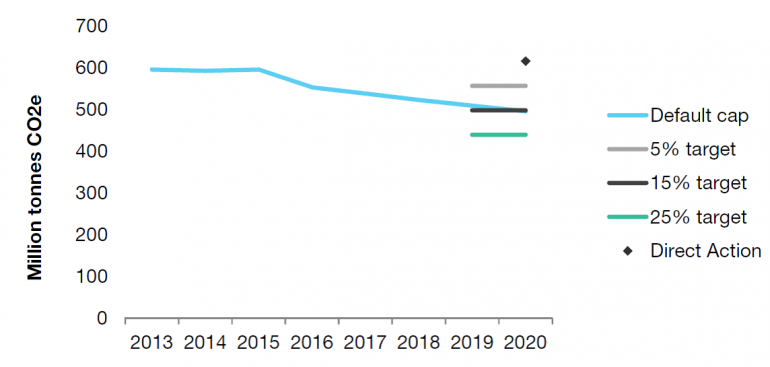Emission trading's automatic 15%
The emissions trading scheme implemented by the prior Labor Government requires that by May 2014 the government propose to parliament regulations specifying what emissions caps will apply under the scheme, otherwise default levels of emission reductions are triggered.
Default emission reduction levels relative to 2012-13 emissions were inserted into the legislation to cover for the event that a subsequent parliament was unable to agree on a future government’s proposed emission targets. In particular, in anticipation that Tony Abbott would be elected and seek to neuter or abolish the ETS.
According to analysis by The Climate Institute, as Australia’s emissions are tracking substantially lower than was anticipated when the ETS was conceived, these default emission reductions would mean Australia would achieve far more than the minimum 5 per cent emission reduction target by 2020. A target which Tony Abbott is refusing to budge from.
The Climate Institute suggests the default emission reductions specified in the legislation would reduce Australia’s emissions by around 15 per cent on 2000 levels by 2020 – overall six times more than previously estimated under the proposed Direct Action Plan and at little extra cost. Although this is largely a function not of emission reductions in Australia, but rather the purchase of large quantities of international carbon credits. These international carbon credits are extremely cheap at present because the emission caps under the European ETS have turned out to be far too generous.
The chart below outlines The Climate Institute’s estimates of how the default emission reductions would affect Australia’s emissions out to 2020, after deducting the use of international carbon credits. It illustrates that Australia’s emissions would be substantially lower than the 5 per cent reduction target, and well below what is expected to be delivered by the current budget allocated to the Coalition’s Direct Action abatement purchasing fund.
Figure 1: Australia’s emissions under legislative default caps, relative to targets and Direct Action (net of international carbon credits).

Source: The Climate Institute (2013)
The default cap is defined relative to Australia’s fiscal year 2012-13 emissions covered by the emission trading scheme. Based on the Clean Energy Regulator’s preliminary estimates of 2012-13 emission numbers, and adjusting these to capture updated Global Warming Potentials, emissions were 296 million tonnes.
The default cap requires a 38 million tonne reduction in covered sector emissions on FY 2012-13 levels in FY 2015-16 and a 12 million tonne annual reduction thereafter.
Of course, this could all be rather academic if Abbott manages to repeal the carbon price bills soon after the new Senate take its seats, so much will hang on the outcome of Western Australia's second attempt to vote for its senators.













